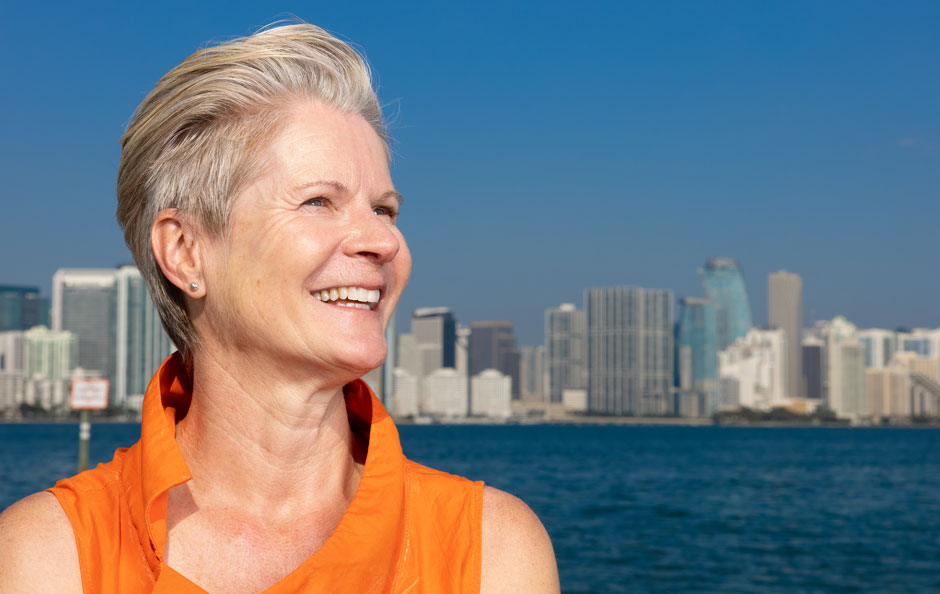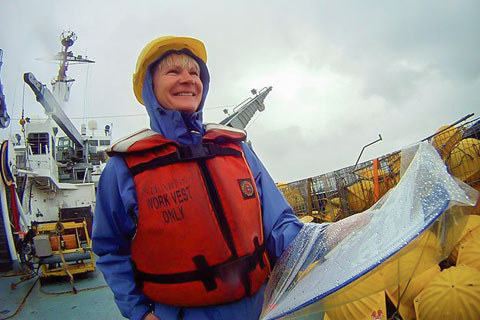University of Miami oceanographer Lisa Beal is renowned for her field studies on the Agulhas Current and its impact on climate change.
The powerful swells can break a container ship in half.
Lisa Beal had heard mariners talk about the force of such waves, but she never really believed them, dismissing their accounts as tall sea tales.
Then, one day during a research expedition to the Indian Ocean, she experienced what makes rogue waves so dangerous.
"I can only describe it as being on a roller coaster. One minute, you're seeing nothing but the ocean; the next, only the sky," the University of Miami physical oceanographer recalled of her encounter with the unusually steep swells, which can overwhelm and damage even the largest of ships.
Seasoned skippers steer their vessels away from such violent waves and into calmer waters. But on the day Beal experienced them, the sea was unforgiving. The swells, spawned by a storm born in the Southern Ocean, came upon the R/V Melville so fast, there was no time to navigate into safer waters. So, the ship's captain pointed the bow into the waves to ride out the storm. And Beal, standing on the bridge, grabbed hold of a rail and hung on for dear life. By the time the waves had finished tossing the 279-foot Melville about, the vessel had strayed more than 100 miles from where it was supposed to be.
If Beal had entertained any thoughts of abandoning the cruise, she quickly dismissed them, for she had come to the Indian Ocean for an important reason. The Agulhas Current, one of the swiftest and strongest in the world, makes its home there, influencing climate patterns around the globe. Beal wanted to learn more about how it does so, and the moorings, current meters, and other scientific equipment she and her team of researchers secured on the Melville's deck would help her find out.
"It's the Indian Ocean's version of the Gulf Stream, but it's a bit of an enigma," Beal, a professor of ocean sciences at the University's Rosenstiel School of Marine, Atmospheric, and Earth Science, said of the Agulhas Current.
Studying the Agulhas
A western boundary current, the Agulhas flows along the east coast of South Africa, transporting warm, salty water toward the Southern Ocean.
Portuguese explorer Vasco da Gama mentions the current in ship's logs during his 1497 voyage from Lisbon to India, describing how his flotilla of four ships encountered a strong, southward current near South Africa's Port Elizabeth that held them back for three days. "Western boundary currents are some of the most intense in the ocean," said Beal, noting that the Agulhas carries 400 times the discharge of the Amazon River.
She has studied the Agulhas since her graduate school days at the University of Southampton in the United Kingdom, deploying to the Indian Ocean on nine expeditions that lasted for weeks at sea. As chief scientist on those cruises, Beal quantified how much water, heat, and salt the Agulhas carries as an artery of Earth's climate system.
Her Agulhas Current Time (ACT) Series—three research cruises from 2010 to 2013, one of which saw her experience rogue waves while on the Melville—produced some of the most captivating, and surprising, scientific data on the current. Combining shipboard measurements with more than 20 years of satellite data, she and her team discovered that the current has broadened, not strengthened, since the early 1990s.
"We weren't expecting that," Beal said. "Based on observations from space, we've seen that these regions are warming at three times the rate of the rest of the world's oceans. We also understand from atmospheric scientists that the world's wind systems are intensifying and expanding poleward with climate change. So, we expected the Agulhas was intensifying over time. But that just isn't the case. It has broadened, and it may even weaken in the future largely because there are now more eddies. So, the current is more turbulent."
That study, which was funded by the National Science Foundation, suggests that the rapid rates of warming in western boundary current regions may be related to more turbulence of those current systems.
She followed up her ACT voyages with a joint scientific mission with South African scientists in 2016—this time, studying heat carried by the Agulhas. The current dominates the heat budget of the Indian Ocean, impacting sea level rise, sea surface temperature, East African rainfall, and storm tracks. And some of the current's waters even leak directly into the Atlantic Ocean. "Any heat that's exchanged from the Indian Ocean either continues poleward or moves into the Atlantic, and it can change or moderate climate in those different regions. So, we wanted to get a handle on that," Beal explained.
Combining moored measurements with a cluster of robotic instruments that drift throughout the ocean, moving up and down between the surface and midwater level, Beal and her team were able to estimate for the first time how the heat transport of the Indian Ocean varies over time.

Upcoming deployment
A 26-day expedition in March 2023 aboard the Scripps Institution of Oceanography's 277-foot Roger Revelle will be unlike any scientific cruise Beal has ever led. "We'll again be following Agulhas waters, but our focus will expand into the Atlantic," she said. "The Agulhas flows along the South African coast, but that boundary eventually runs out. You get to the Cape of Good Hope and it's just open ocean from there."
The main current doubles back on itself to remain in the Indian Ocean, but as it does so, it sheds rings, eddies, and filaments that carry warm, turbulent waters into the Atlantic. "And any time the atmosphere or ocean system can transport heat from one place to another, it's going to affect climate fundamentally," Beal said.
In the past, scientists, including Beal, have only been able to estimate how much water from the Indian Ocean moves into the Atlantic by observing drifters and floats that have crossed from one of the oceans to the other. But only a handful of those instruments have made that passage, leaving a huge gap in what scientists know about Agulhas leakage.
During the upcoming March expedition, Beal, co-principal investigator Kathleen Donohue of the University of Rhode Island, and an international team of researchers will take a novel approach to study the Agulhas, employing a multitude of instruments to measure the diffusion—or eddy flux—of heat through the open ocean of the Cape Basin. They will use surface drifters and robotic floats; 'tricked out' moorings with 30 to 40 instruments strung over four kilometers of vertical wire; automated vehicles such as gliders, sail-buoys, and sea-explorers; as well as something called a WireFlyer, a new instrument invented by University of Rhode Island ocean engineer Chris Roman that is capable of sampling vertical swaths of the ocean. All these measurements will dovetail with NASA's new SWOT satellite that will observe the dynamics of the ocean surface at unprecedented small scales, Beal said.
The nearly monthlong expedition will not be the longest deployment for Beal. She once spent 47 straight days at sea as part of the field phase of the World Ocean Circulation Experiment, crossing the Indian Ocean from South Africa to Australia. "I stayed sane by breaking out some Michael Jackson moves on the flying bridge, listening on my fancy, new iPod," Beal said.
Long sea voyages
Extended research voyages to unlock the secrets of the sea, Beal said, can strain the emotions, challenging a scientist's patience when it comes to living in close quarters with others and not being able to see or speak to loved ones for days on end.
"It's this odd other existence away from your typical life, and it's not for everybody," Beal said. "You're sometimes thrown together with other researchers and crewmembers you don't know. So, you end up lacking the support of family and friends. So, it can be tough, especially for women." She recounted experiences of harassment and disrespect at the hands of some male crew members and scientists. "It has gotten better for women, but we still have a way to go," she said.
Long scientific cruises, she said, are also immensely rewarding. "They can bring some intense happiness. While it's just you and a ship and the endless ocean, you do make friends for life. We know that we're working together as a team to accomplish something, that we're working together out there to be safe," Beal said. "And there's no substitute for teamwork out there; there's no individuality about it. Even meals are taken together."
 Beal has logged 357 days at sea on 17 research voyages to the Atlantic and Indian oceans, serving as chief scientist on many of those expeditions.
Beal has logged 357 days at sea on 17 research voyages to the Atlantic and Indian oceans, serving as chief scientist on many of those expeditions.
The role our oceans play in shaping global climate has been vastly underestimated, Beal pointed out.
"In terms of the global carbon cycle, our oceans have huge reserves of carbon, and they're able to cycle that carbon back and forth with the atmosphere on much shorter timescales," Beal said. "They also hold more than 90 percent of the excess heat trapped in the Earth system due to human-induced climate change. So, the questions we have are, 'How long will that heat remain in the ocean? Where will it be given up to the atmosphere? And how will those feedbacks from the ocean to the atmosphere affect the future of our climate?' "
Beal's ocean deployments are well worth it, as the data she collects, analyzes, and releases can help a myriad of sources around the world, from scientists who write the United Nations Intergovernmental Panel on Climate Change reports to government officials who want to know where the heat and carbon in the ocean is going.
But had Beal pursued a passion born during her teenage years, she might have been hauling people and supplies to remote areas in Africa as an aviator instead of plying the seas as a scientist studying the link between the oceans and climate. "I started out in aeronautical engineering, and I wanted to be a bush pilot," she recalled. "I saw the movie 'Out of Africa.' I wanted to be Robert Redford. It didn't occur to me that others would expect me to be Meryl Streep."
Beal is a longtime advocate for women and underrepresented groups in the sciences. "In order to embrace what science informs us about ourselves and our planet, everyone needs to be a part of it," Beal said. "When we do not include everyone in the science, we have blind spots. And the science suffers."
To promote women in oceanography, Beal produced a short film that has been adopted by the Smithsonian. She also led a group of South African schoolchildren on a tour of a U.S. research vessel while in Cape Town, and she co-organized the first American Geophysical Union Chapman Conference on the African continent. On the international stage, Beal led a review of the state of the Indian Ocean observing system on behalf of the Intergovernmental Oceanographic Commission of UNESCO, and she is currently diversifying the board at the Journal of Geophysical Research: Oceans, where she has served as editor in chief since 2021.
Beal is forever connected to the ocean. Her favorite pastime? Ocean swimming.
"After I moved to Miami, I joined the Nadadores Swim Team. We're a fun-loving LGBTQ-friendly team with three practices a week. During the pandemic, all the pools were closed, and we started open-water swimming. Now I swim two miles in the ocean most Sundays with the Dolphins and Rainbows swim group, in addition to one or two practices a week with the Nadadores," Beal said. "For me, ocean swimming is therapy, exercise, and community."






